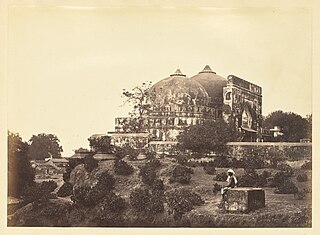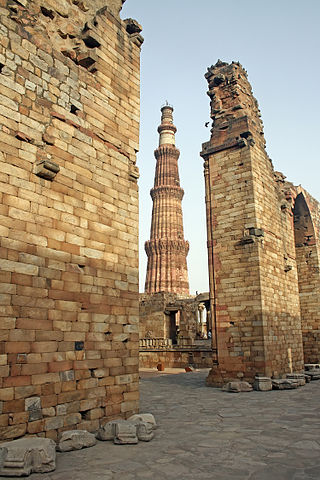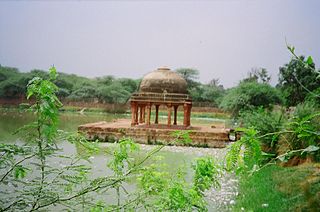Related Research Articles

Babri Masjid was a mosque in Ayodhya, India. It has been claimed to have been built upon the site of Ram Janmabhoomi, the legendary birthplace of Rama, a principal deity of Hinduism. It has been a focus of dispute between the Hindu and Muslim communities since the 19th century. According to the mosque's inscriptions, it was built in 1528–29 by Mir Baqi, a commander of the Mughal emperor Babur. Before the 1940s, the masjid was officially known as "Masjid-i-Janmasthan". The mosque was attacked and demolished by a Hindu nationalist mob in 1992, which ignited communal violence across the Indian subcontinent.

The Qutb Minar complex are monuments and buildings from the Delhi Sultanate at Mehrauli in Delhi, India. Construction of the Qutub Minar "victory tower" in the complex, named after the religious figure Sufi Saint Khwaja Qutbuddin Bakhtiar Kaki, was begun by Qutb-ud-din Aibak, who later became the first Sultan of Delhi of the Mamluk dynasty. It was continued by his successor Iltutmish, and finally completed much later by Firoz Shah Tughlaq, a Sultan of Delhi from the Tughlaq dynasty (1320–1412) in 1368 AD. The Qubbat-ul-Islam Mosque, later corrupted into Quwwat-ul Islam, stands next to the Qutb Minar.
Ram Janmabhoomi is the site that, according to Hindu religious beliefs, is the birthplace of Rama, the seventh avatar of the Hindu deity Vishnu. The Ramayana states that the location of Rama's birthplace is on the banks of the Sarayu river in a city called "Ayodhya". Modern-day Ayodhya is in the north Indian state of Uttar Pradesh. It is contested whether the Ayodhya mentioned in the Ramayana is the same as the modern city.

Mehrauli is a neighbourhood in South Delhi, Delhi, India. It represents a constituency in the legislative assembly of Delhi. The area is close to Gurugram and next to Vasant Kunj.

The Ayodhya dispute is a political, historical, and socio-religious debate in India, centred on a plot of land in the city of Ayodhya, Uttar Pradesh. The issues revolve around the control of a site regarded since at least the 18th century among many Hindus to be the birthplace of their deity Rama, the history and location of the Babri Masjid mosque at the site, and whether a previous Hindu temple was demolished or modified to create the mosque.

The Tomb of Ghiyas ud din Balban is located in Mehrauli Archaeological Park, Mehrauli, southern part of New Delhi, India. Built in circa 1287 CE in rubble masonry, the tomb is a building of historical importance in the development of Indo-Islamic architecture, as it was here that first Islamic arch made its appearance in India, and according to many, the first Islamic dome as well, which however hasn't survived, making Alai Darwaza built in 1311 CE, in the nearby Qutb complex, the earliest surviving dome in India. Ghiyas ud din Balban (1200–1287) was a Turkic ruler of the Delhi Sultanate during the rule of Mamluk dynasty of Delhi from 1266 to 1287. He was one of the most prominent rulers of the Slave Dynasty. The tomb of Balban was discovered in the mid-20th century.

Sultan Ghari was the first Islamic Mausoleum (tomb) built in 1231 AD for Prince Nasiruddin Mahmud, eldest son of Iltumish, in the "funerary landscape of Delhi" in the Nangal Dewat Forest, Near Nangal Dewat Vasant Kunj).

The Khirki Mosque is a former mosque, now in partial ruins, located in Khirki Village, near Satpula, in South Delhi, India. The mosque was built by Khan-i-Jahan Junan Shah, the prime minister of Feroz Shah Tughlaq (1351–1388) of the Tughlaq Dynasty. The former mosque can be approached from Satpula or the seven–arched bridge on the edge of southern wall of Jahanpanah.

Jahanpanah was the fourth medieval city of Delhi established in 1326–1327 by Delhi Sultan, Muhammad bin Tughlaq. To counter the persistent threat of Mongol invasions, Tughlaq constructed the fortified city of Jahanpanah, incorporating the Adilabad Fort, built in the 14th century, along with all the establishments located between Qila Rai Pithora and Siri Fort. Neither the city nor the fort has survived. Many reasons have been offered for such a situation. One of these is exemplified by the idiosyncratic rule of Mohammed bin Tughlaq, who inexplicably decreed the capital to be moved to Daulatabad in the Deccan, only to return to Delhi soon after.

Hauz-i-Shamsi, also known as Shamsi Talab, is a water reservoir built by Iltutmish of the Slave Dynasty in 1230 CE. According to legend, its location was revealed to him in a dream by the Islamic prophet Muhammad. A palace known as the Jahaz Mahal was constructed on the eastern edge of the same reservoir during the Lodi dynasty in the 16th century, serving as a retreat or inn for pilgrims. At the edge of Hauz-i-Shamsi stands the tomb of Abdul-Haqq Dehlavi, a 17th-century Persian writer at the Mughal court. The monuments are situated in the sprawling environs of Mehrauli, Delhi.

Zafar Mahal, in Mehrauli village, in South Delhi, India, is considered as the last monumental structure built as a summer palace during the fading years of the Mughal era. The building has two components namely, the Mahal or the palace, which was built first by Akbar Shah II in the 18th century, and the entrance gate that was reconstructed in the 19th century by Bahadur Shah Zafar II, popularly known as "Zafar" meaning ‘Victory’. It has a forlorn history because Bahadur Shah Zafar, who wished to be buried in the precincts of the Zafar Mahal (palace) and the famous Dargah of Khwaja Qutubuddin Bakhtiar Kaki in Mehrauli, Delhi, was deported by the British to Rangoon, after the First War of Indian Independence in 1857, where he died of old age. The monument today is in a neglected and ruined state, locals play cricket and gamble freely inside the protected monument. The 18th-century palace has been all but subsumed by unauthorised constructions.

The Jamali Kamali Mosque and Tomb is a Sufi mosque and mausoleum complex that contains the tombs of Jamali and Kamali, co-located in the archaeological village of Mehrauli, in South Delhi, India. The mosque and the tomb were constructed in c. 1529, and Jamali was buried in the tomb after his death in 1535.

The Feroz Shah Kotla or Kotla was a fortress built circa 1354 by Feroz Shah Tughlaq to house his version of Delhi called Firozabad.

Firoz Shah palace complex (Hisar-e-Firoza) is an archaeological complex located in modern-day Hisar, in the Haryana state of India, built by Firoz Shah Tughlaq of the Delhi Sultanate in 1354 AD. It is maintained by the Archaeological Survey of India.

The Mehrauli Archaeological Park is an archaeological area spread over 81 hectares in the Mehrauli neighbourhood of the South Delhi district of Delhi, India. The park is located adjacent to the World Heritage-listed Qutub Minar and the Qutb complex.

The Jama Masjid Shamsi also known as Jama Shamsi Shahi is a mosque a major mosque built in the historic center of Budaun, Uttar Pradesh, India.

The Baolis of Mehrauli are four stepwells approached through single stage or three stage steps, located in Mehrauli in Delhi, India, in the Mehrauli Archaeological Park mainlined by the Archaeological Survey of India. These are the Anangtal Baoli, the Gandhak Ki Baoli, and the Rajon Ki Baoli. These were built below the ground level as ground water edifices and were built near shrines in medieval times.

The Lat Mosque is a mosque in Dhar in the state of Madhya Pradesh, India. Named after the Iron pillar of Dhar, it is also known as Lat ki masjid, Ladh Masjid, or Lath Masjid.

The Sunehri Bagh Masjid is a Mughal era mosque, located in the Lutyens area, in Central Delhi, India. It is listed as a Grade-III heritage structure and is made of two storeys, and comprises a Bangla dome and four minarets.

The Begumpur Mosque or Begumpur Masjid, also known as the Jam'i Masjid of Jahanpanah, is a former Friday mosque, now in partial ruins, located in an urban village called Begumpur, which now bears its modern name, Jahanpanah. The former mosque was built in the centre of the sultanate capital of the Tughluq dynasty, in c. 1343 CE. The former mosque is large, measuring 94 by 90 metres.
References
- ↑ Bakhsh, Zenaira (1 February 2024). "'How can 800-yr-old masjid be an encroachment?' Mehrauli mosque demolition confounds historians". ThePrint. Retrieved 17 December 2024.
- 1 2 "700-Year-Old Mosque Razed by DDA". The Wire. Retrieved 16 December 2024.
- ↑ "Mehrauli: A mosque demolished, and orphans displaced in India". BBC News. 9 February 2024. Retrieved 16 December 2024.
- 1 2 "Delhi High Court Asks DDA to Explain Mosque Demolition". Scroll.in. Retrieved 16 December 2024.
- 1 2 "Masjid Akhonji: 700-Year-Old Mosque Razed by DDA, Court Asked to Intervene". The Wire. Retrieved 16 December 2024.
- ↑ "600-Year-Old Mosque Demolished in Delhi". The Kashmiriyat. Retrieved 16 December 2024.
- ↑ Mogul, Rhea (15 February 2024). "'Erasing a part of history' – What a double mosque demolition tells us about India ahead of crucial election". CNN. Retrieved 16 December 2024.
- ↑ "Masjid Akhonji: 700-Year-Old Mosque Razed by DDA, Court Asked to Intervene". The Wire. Retrieved 16 December 2024.